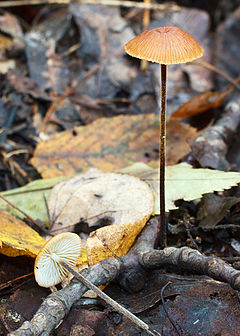Rhizomarasmius
| Rhizomarasmius | |
|---|---|

| |
| Rhizomarasmius pyrrhocephalus | |
| Scientific classification | |
| Kingdom: | |
| Division: | |
| Class: | |
| Order: | |
| Family: | |
| Genus: | Rhizomarasmius R.H.Petersen (2000) |
| Type species | |
| Rhizomarasmius pyrrhocephalus (Berk.) R.H.Petersen (2000) | |
| Species | |
Rhizomarasmius is a genus of fungi in the family Physalacriaceae, containing about five species.[3]
General
The genus was created in 2000 by R. H. Petersen to accommodate two species then classified in Marasmius (M. pyrrhocephalus and M. undatus), but which do not belong there due to morphological grounds, including the nature of the cystidia and the way the mushrooms are rooted on a plant substrate. This analysis was backed up in 2006 by DNA comparisons done by Wilson and Desjardin.[4][2][5]
Unlike most Marasmius mushrooms, members of Rhizomarasmius grow on the rhizomes of ferns or flowering plants, and that is the signification of the genus name. Instead of the Marasmiaceae this genus is placed in the Physalacriaceae, a sister clade but a separate family.[4]
Species
| Image | Name | Notes | Distribution |
|---|---|---|---|
 |
R. epidryas | Arctic, Altai Mountains & mountains in Europe & N. America | |
| R. oreinus | |||
 |
R. pyrrhocephalus | Type species | N. America |
 |
R. setosus | = Marasmius setosus, Marasmius recubans | Europe |
 |
R. undatus | Europe, N. America, Altai Mountains |
See also
References
- ^ Ronikier M, Ronikier A (2011). "Rhizomarasmius epidryas (Physalacriaceae): phylogenetic placement of an arctic-alpine fungus with obligate saprobic affinity to Dryas spp". Mycologia. 103 (5): 1124–1132. doi:10.3852/11-018. PMID 21482630. S2CID 42900871.
- ^ a b Petersen RH. (2000). "Rhizomarasmius, gen. nov. (Xerulaceae, Agaricales)". Mycotaxon. 75: 333–342.
- ^ Moreau PA, Vila J, Aime MC, Antonín V, Horak E, Pérez-Butrón JL, Richard F, Urban A, Welti S, Vizzini A (2015). "Cibaomyces and Cyptotrama, two new genera for Europe, and an emendation of Rhizomarasmius (Basidiomycota, Physalacriaceae)". Mycological Progress. 14 (2): 4. Bibcode:2015MycPr..14....4M. doi:10.1007/s11557-015-1024-4. hdl:2318/153555. S2CID 14276031.
- ^ a b Antonín, V.; Noordeloos, M. E. (2010). A monograph of marasmioid and collybioid fungi in Europe. Berchtesgaden, DE: IHW Verlag. pp. 427–430. ISBN 978-3-930167-72-2.
- ^ Wilson A, Desjardin D (2005). "Phylogenetic relationships in the gymnopoid and marasmioid fungi (Basidiomycetes, euagarics clade)". Mycologia. 97 (3): 667–679. doi:10.3852/mycologia.97.3.667. PMID 16392255.
